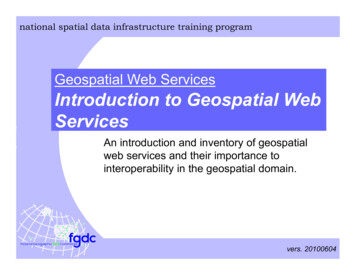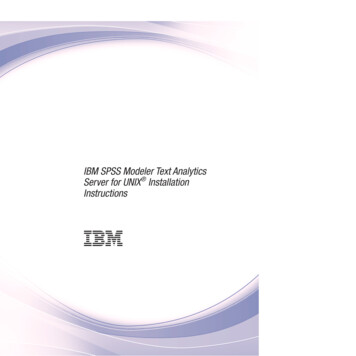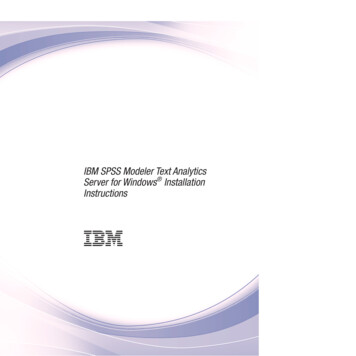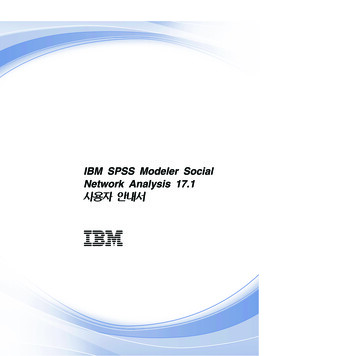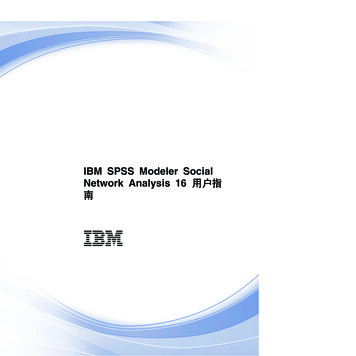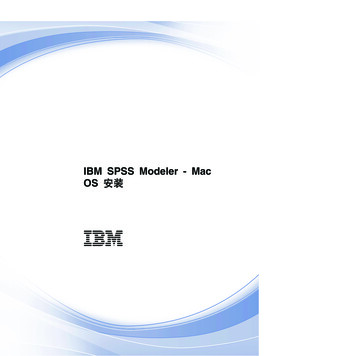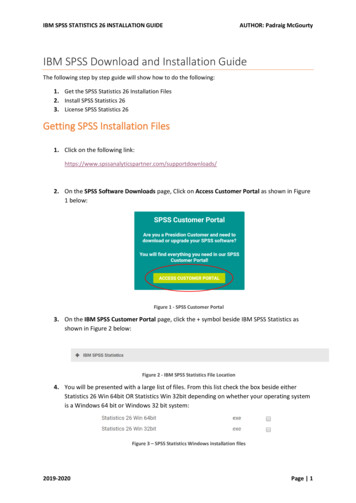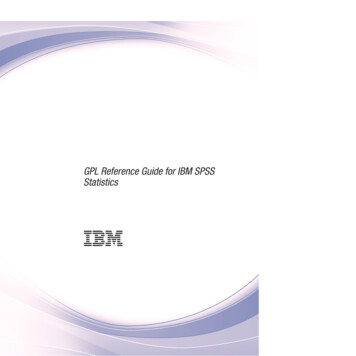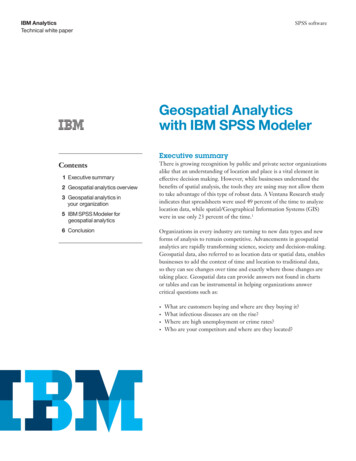
Transcription
IBM AnalyticsTechnical white paperSPSS softwareGeospatial Analyticswith IBM SPSS ModelerExecutive summaryContents1 Executive summary2 Geospatial analytics overview3 Geospatial analytics inyour organization5 IBM SPSS Modeler forgeospatial analytics6 ConclusionThere is growing recognition by public and private sector organizationsalike that an understanding of location and place is a vital element ineffective decision making. However, while businesses understand thebenefits of spatial analysis, the tools they are using may not allow themto take advantage of this type of robust data. A Ventana Research studyindicates that spreadsheets were used 49 percent of the time to analyzelocation data, while spatial/Geographical Information Systems (GIS)were in use only 23 percent of the time.1Organizations in every industry are turning to new data types and newforms of analysis to remain competitive. Advancements in geospatialanalytics are rapidly transforming science, society and decision-making.Geospatial data, also referred to as location data or spatial data, enablesbusinesses to add the context of time and location to traditional data,so they can see changes over time and exactly where those changes aretaking place. Geospatial data can provide answers not found in chartsor tables and can be instrumental in helping organizations answercritical questions such as: What are customers buying and where are they buying it?What infectious diseases are on the rise?Where are high unemployment or crime rates?Who are your competitors and where are they located?
IBM AnalyticsTechnical white paperSPSS softwareGeospatial data often describes address-related data(a specific address, point of interest, ZIP code, and so on),which can be matched to a specific latitude and longitudeusing a process known as geocoding. Geocodes for addressesand points of interest can also be integrated with other datasources to enhance analysis in dashboards, visualizations,and more advanced modeling.The demand for geospatial insights has created a distinctneed for accessible, self-service tools that enhance predictiveanalytics through the use of new algorithms designedspecifically for the analysis of geospatial data — tools thatcan better support the business data analysis process andhelp organizations make more informed decisions.Geospatial analytics augments and enhances the rigorof predictive models by adding dimensions to the datathrough elements of time and space.Geospatial data sources include: Geospatial analyticsThe geospatial services industry is expanding widely withcontinued growth across all industries—approximately500,000 people are employed with approximately 75 billionbeing generated in annual revenue. Advancements ingeospatial analytics are rapidly transforming science,society and decision-making. Global positioning system (GPS) data is gatheredthrough satellite and ground-based radio navigationsystems. A GPS-enabled smartphone can provide thelocation of a person, for instance.Remote sensing involves specialized instruments,including satellites, scanners and radar systems, thatcapture data which be converted into digital form.Geospatial analyticsThis white paper provides an overview of geospatial analyticsand why it is important to organizations seeking deeperinsights about their business, customers or constituents.It then describes the geospatial analytics capabilities offeredin IBM SPSS Modeler, and how these capabilities canenhance predictive models by augmenting traditional formsof business data with time and location-based intelligence.Geospatial analytics is useful in many industriesand applications:Geospatial analytics overview Increasingly, companies are looking to a variety of datatypes and new forms of analysis in order to remaincompetitive. Forward looking companies are developinganalytics ecosystems that make use of disparate kinds of data,including text data, social media data, and geospatial data. Geospatial data or geographic information is the dataor information that identifies the geographic locationof features and boundaries on Earth, such as natural orconstructed features, oceans, and more. Spatial data is usuallystored as coordinates and topology, and is data that canbe mapped. Spatial data is often accessed, manipulated oranalyzed through Geographic Information Systems (GIS). 2A retail chain can strategically plan for store expansionby understanding areas in which the supply of product ispredicted to be lower than the demand.A healthcare organization can study disease outbreaksover time at specific locations and more adequately preparefor potential epidemics.Law enforcement agencies can study past geospatialdata to see crime “hot spots” and use that insight topredict and prevent future crimes in those areas.Insurers can incorporate geospatial insights into theirunderwriting process to determine which customers areat higher risk of flood, hurricanes, or earthquakes.Government agencies can detect fraud in social programs,such as the Supplemental Nutrition Assistance Program(food stamps) or Medicare.Financial services firms can use the geographic locationof transactions to spot potential credit card fraud.
IBM AnalyticsTechnical white paperSPSS softwareGeospatial analytics in your organizationwidely dispersed locations. Geospatial analysis can helporganizations analyze and improve service areas, study therelationship between signal coverage and customer service,keep track of vehicles in a fleet, or manage facilities moreefficiently and cost effectively.Geospatial analytics improves predictive insights byaccounting for both time and space in predictive models,so you can more accurately forecast events at a specificlocation for any future point in time. This can help yousee patterns and trends in a familiar geographic context, sothey’re easier to understand and respond to; anticipate andprepare for changing spatial conditions or location-basedevents; and develop targeted solutions to business challengesthat may require different responses in different locations.Crime forecastingGeospatial data is integral to law enforcement agencies inthe prediction and prevention of crime. Predictive analyticsis advancing rapidly to help uncover unknown patterns,and to give law enforcement better insight into where tobest place resources at the right place and at the right time.Instead of scanning addresses and names on paper documents,investigators can view crime locations on a map along withinformation about known criminals in the area. Seeing thedifferent types of data in one place enables departments toidentify and apprehend suspects faster. Analysis can alsobe used for issuing alerts, identifying high crime rate areasand predicting when and where a crime is likely to occur.Geospatial data can also help agencies map calls for service,reports of suspicious activity, assist in emergency managementincidents, and help detect and prevent terrorist threats.Geospatial analysis is useful in many business functions,from marketing to operations, and has applications in justabout any industry.Market segmentationMarketers have traditionally relied on spreadsheets, graphsand charts to tell them who their customers are, what theybuy and how much they spend. But integrating geographicinformation such as where people live or where they makepurchases can dramatically enhance the effectiveness ofmarketing campaigns. Geospatial analytics in marketingcan help target new customers and maximize promotionalopportunities through similar characteristics, such as age,income or interests. This type of market segmentation canhelp improve promotions and retention and obtain moreloyal customers. For example, retailers and other businessesmight use loyalty card information and ZIP codes to helpvisualize where customers in a particular segment live. Inaddition, location data can be used from the GPS on thetarget segment’s smartphones to push offers during a certaintimeframe, or while the customers are in-store, to influencecertain types of purchases or to determine how to rewardtheir most loyal customers.Asset and field managementThere is a growing trend toward using location informationand map visualization for asset management in industries suchas manufacturing, energy and utilities, telecommunications,transportation and construction, where geospatial insightscan be critical when managing physical assets in multiple,Figure 1: In this example, specialized procedures within SPSS Modeler wereused to predict hot spots in which thefts are most likely to occur based ondemographic information for a specific region.3
IBM AnalyticsTechnical white paperSPSS softwareRisk reductionbanks measure the reach of each branch, understandnetwork gaps and redundancies, define a trade area aroundthe branch, and identify its market potential. Geospatialanalytics technology can also be used to create “what if’scenarios and perform dynamic segmentation to locatemultiple classes of assets.Businesses in industries such as communications, insurance,utilities, energy and finance are vulnerable to a range ofthreats and risks, from natural disasters to network outages.Hundreds or even thousands of lives can be affected by theseevents — some of which are foreseeable, and many otherswhich are not. Effective disaster and risk reduction andmanagement can be achieved with the help of geospatialdata, which can be critical during every phase of the riskmanagement process, including prevention, mitigation,preparedness, response and relief. Geospatial analytics,combined with layered data on all impacted infrastructure,can help organizations construct predictive models to helpgovernments, developers, and others better understand riskand manage it accordingly.Fraud detection and preventionThe number of people and businesses falling victim to fraudhas increased at an alarming rate. As technology continuesto improve, fraudsters are finding new and creative methodsto continue their work. Financial theft is not the only issue;there is also the cost directly related to business disruptionand loss of productivity. Organized fraud activity, medicalbilling fraud, credit card fraud and staged accident rings areonly a few methods unscrupulous individuals and groups areusing, costing industries billions of dollars. Geospatial datacan help companies detect and prevent fraud by providinginformation about where fraud might occur.Travel and transportation logisticsTravel and transportation providers have a long list ofchallenges to confront, including economic stagnationand fluctuating demand; proliferation of sales channels,loss of market-making power, and commoditization;demanding and empowered customers; high fixed costsfor equipment and infrastructure; fuel price volatilityand cost escalation, and safety and security requirements.Geospatial analytics can help transportation companiesmaximize fleet utilization, monitor actual versus plannedtime to improve routes, monitor service activity, optimizeoperations and meet response time targets.IBM SPSS Modeler for geospatial analyticsIBM SPSS Modeler can help you explore the relationshipof data elements that can be tied to a location and performgeographic spatial analysis of your data to reveal insights thatwould not be visible in charts or tables. With spatial mining,you can easily mine geospatial data using ESRI shape files.By analyzing both non-spatial and spatial data, overall modelaccuracy is improved and you are able to gain deeper insightsinto people and events.Strategic location and market optimizationIdentifying strategic business locations often becomesa market optimization exercise in which the plannersneed to understand the interplay of various factors thatcan affect the choice of a specific location for a new storeor bank branch. Possessing a thorough understandingof the marketplace in which retail operations or financialinstitutions function or would like to operate is integralto profitable growth. For example, geospatial data helpsYou can use SPSS Modeler to apply association rulesthat will help you uncover insightful relationships amongspatial and non-spatial attributes. Using spatial temporalprediction, you can fit linear models for measurements takenover locations in 2D space, enabling you to easily predict“hot” areas and how those areas will change over time.You can apply this technology to mine geospatial data infields such as retail and banking, crime pattern analysis,epidemic surveillance, building management and branchperformance analysis.4
IBM AnalyticsTechnical white paperSPSS softwareConclusionJournalists, researchers and police investigators often usea formula comprised of six basic information-gatheringquestions to ensure they tell the complete story. Thesequestions are who, what, where, when, why and how.This same approach can apply to data analytics, whichis the process of telling a story with data. People andorganizations use analytics to convert data to information,turn information into knowledge, and use that knowledgeto transform business.EsriA police department turns to IBM Business Partner Esrifor an IBM SPSS solution to analyze crime patterns anddevelop effective strategies to reduce crime while optimizingpolice resources. Identifies crime “hot spots” and focuses police resourcesat these locations, helping lower crime rates by 19 percentover four yearsEnables creation of color-coded maps to visualizecrime patternsHelps organized crime units and task forces developplans for special actions and interventionsOrganizations have traditionally used data to answer thequestions who, what and why. While the answers can beinsightful, they do not tell the whole story because they donot extract all potential insights from the data. By investingin an analytical solution that provides location analyticscapabilities, organizations are able to discover where andwhen events are occurring, increasing the value of theirinformation by telling a more complete story throughdata. This enhanced insight can provide a rapid return oninvestment by improving customer service, reducing fraud,speeding innovation and reducing risk. Such factors areconsidered to be key sources of competitive advantage inmany organizations.IBM SPSS Modeler is a powerful predictive analyticsplatform that is designed to bring predictive intelligenceto decisions made by individuals, groups, systems and yourenterprise. SPSS Modeler scales from desktop deploymentsto integration with operational systems to provide you witha range of advanced algorithms and techniques. Applyingthese techniques to decisions can result in rapid ROI andcan enable organizations to proactively and repeatedlyreduce costs while increasing productivity.In response to the need for more comprehensive insights onwhich to base decisions, and the potential that can be gainedby augmenting traditional analytics with geospatial data,IBM offers IBM SPSS Modeler. This self-service analyticaltool empowers users to combine and extract insights from alltypes of data, including data that contains elements of timeand space, to tell a complete story about their customers,constituents, patients, students, assets and operations. Withthis enhanced knowledge, organizations are able to makedecisions that lead to better outcomes.Figure 2: Correlations map and target time series analysis in SPSS Modeler.5
For more informationTo learn more about SPSS Modeler visit: ibm.co/1yLMLHL.To explore prescriptive analytics, which can help you decide how toact on the insights gained through the use of geospatial analytics, visit:ibm.co/1E6dyPz.To learn more about geospatial analytics with IBM SPSS Modeler,please contact your IBM representative or IBM Business Partner, orvisit the following website: ibm.com/developerworks/library/ba-mine spatial-data-spss-r/Additionally, IBM Global Financing can help you acquire the ITsolutions that your business needs in the most cost-effective andstrategic way possible. We’ll partner with credit-qualified clientsto customize an IT financing solution to suit your business goals,enable effective cash management, and improve your total cost ofownership. IBM Global Financing is your smartest choice to fundcritical IT investments and propel your business forward. For moreinformation, visit: ibm.com/financing. Copyright IBM Corporation 2015IBM Corporation1 New Orchard RoadArmonk, NY 10504Produced in the United States of AmericaApril 2015IBM, the IBM logo and ibm.com are trademarks ofInternational Business Machines Corp., registered inmany jurisdictions worldwide. Other product and servicenames might be trademarks of IBM or other companies.A current list of IBM trademarks is available on theWeb at “Copyright and trademark information” atwww.ibm.com/legal/copytrade.shtml.This document is current as of the initial date of publicationand may be changed by IBM at any time. Not all offeringsare available in every country in which IBM operates.The performance data and client examples cited arepresented for illustrative purposes only. Actual performanceresults may vary depending on specific configurations andoperating conditions. Actual results may vary. It is the user’sresponsibility to evaluate and verify the operation of anyother products or programs with IBM products and programs.THE INFORMATION IN THIS DOCUMENT ISPROVIDED “AS IS” WITHOUT ANY WARRANTY,EXPRESS OR IMPLIED, INCLUDING WITHOUTANY WARRANTIES OF MERCHANTABILITY,FITNESS FOR A PARTICULAR PURPOSE ANDANY WARRANTY OR CONDITION OF NON INFRINGEMENT. IBM products are warranted accordingto the terms and conditions of the agreements under whichthey are provided.The client is responsible for ensuring compliance withlaws and regulations applicable to it. IBM does not providelegal advice or represent or warrant that its services orproducts will ensure that the client is in compliance withany law or regulation.Actual available storage capacity may be reported for bothuncompressed and compressed data and will vary and maybe less than stated.1 e RecycleYTW03412-USEN-00
IBM SPSS Modeler for geospatial analytics . IBM SPSS Modeler can help you explore the relationship of data elements that can be tied to a location and perform geographic spatial analysis of your data to reveal insights that would not be visible in charts or tables. With spatial mining, you can easily mine geospatial data using ESRI shape iles.


